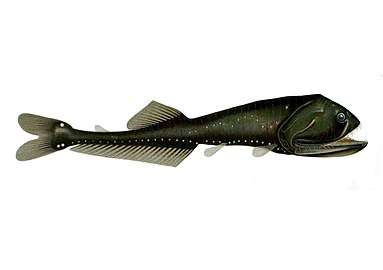Gonostomatidae
The Gonostomatidae are a family of mesopelagic marine fish, commonly named bristlemouths, lightfishes, or anglemouths. It is a relatively small family, containing only eight known genera and 32 species. However, bristlemouths make up for their lack of diversity with numbers: Cyclothone, with 12 species, is thought to be (along with Vinciguerria) the most abundant vertebrate genus in the world, numbering in the hundreds of trillions to quadrillions.[1]
| Bristlemouths | |
|---|---|
 | |
| Elongated bristlemouth, Gonostoma elongatum (top) and Bonapartia pedaliota (bottom) | |
| Scientific classification | |
| Kingdom: | |
| Phylum: | |
| Class: | |
| Order: | |
| Family: | Gonostomatidae |
| Genera | |
|
Bonapartia | |
The fossil record of this family dates back to the Miocene epoch. Living bristlemouths were discovered by William Beebe in the early 1930s and described by L. S. Berg in 1958. The fish are mostly found in the Atlantic, Indian, and Pacific Oceans, although the species Cyclothone microdon may be found in Arctic waters. They have elongated bodies from 2 to 30 cm (0.79 to 11.81 in) in length.[2] They have a number of green or red light-producing photophores aligned along the undersides of their heads or bodies. Their chief common name, bristlemouth, comes from their odd, equally sized, and bristle-like teeth. They are typically black in color which provides camouflage from predators in deep, dark waters.
Taxonomy
Some classifications include the genera Pollichthys and Vinciguerria, but this article follows FishBase in placing them in the family Phosichthyidae.
Some classifications include species in the genus Zaphotias, but these are junior synonyms of the species Bonapartia pedaliota.
| Genus | Image | Species | Description |
|---|---|---|---|
| Bonapartia |  |
1 | There is only one described species in this genus. It grows to a length of 7.2 centimetres (2.8 in) SL.[3] |
| Cyclothone | 13[4] | Cyclothone is a genus of bioluminescent bristlemouths. They are typically about 3 inches long and found usually at depths exceeding 1000 feet.[5] This genus contains more individuals than any other vertebrate genus. | |
| Diplophos | 5 [6] | ||
| Gonostoma | 3 [7] | ||
| Manducus | 2 [8] | ||
| Margrethia | .gif) |
2 [9] | |
| Sigmops |  |
4 [10] | |
| Triplophos | 1 | There is only one described species in this genus. It grows to a length of 36 centimetres (14 in) SL.[11] |
References
- Broad, William J. (June 29, 2015). "An Ocean Mystery in the Trillions". The New York Times. Retrieved August 1, 2015.
- Fink, William L. (1998). Paxton, J.R.; Eschmeyer, W.N. (eds.). Encyclopedia of Fishes. San Diego: Academic Press. p. 121. ISBN 0-12-547665-5.
- Froese, Rainer and Pauly, Daniel, eds. (2012). "Bonapartia pedaliota" in FishBase. February 2012 version.
- Froese, Rainer and Pauly, Daniel, eds. (2012). Species of Cyclothone in FishBase. February 2012 version.
- Proujan, C. (1979). Secrets of the Sea (2nd ed.). London: Reader's Digest Association. p. 60. OCLC 30992870.
- Froese, Rainer and Pauly, Daniel, eds. (2012). Species of Diplophos in FishBase. February 2012 version.
- Froese, Rainer and Pauly, Daniel, eds. (2012). Species of Gonostoma in FishBase. February 2012 version.
- Froese, Rainer and Pauly, Daniel, eds. (2012). Species of Manducus in FishBase. February 2012 version.
- Froese, Rainer and Pauly, Daniel, eds. (2012). Species of Margrethia in FishBase. February 2012 version.
- Froese, Rainer and Pauly, Daniel, eds. (2012). Species of Sigmops in FishBase. February 2012 version.
- Froese, Rainer and Pauly, Daniel, eds. (2012). "Triplophos hemingi" in FishBase. February 2012 version.
- Froese, Rainer, and Daniel Pauly, eds. (2012). "Gonostomatidae" in FishBase. February 2012 version.